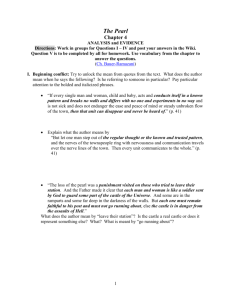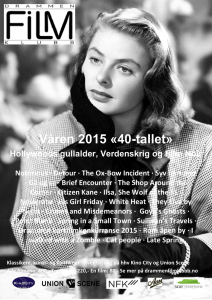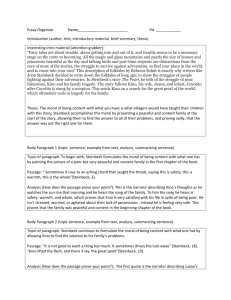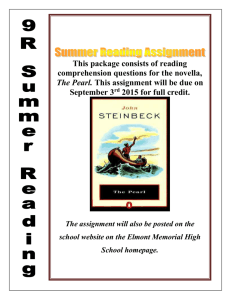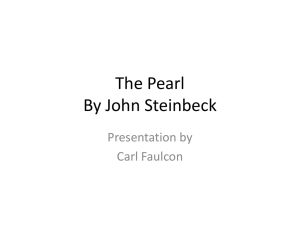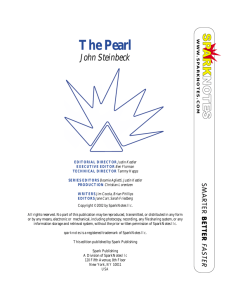Grade 8 - Saint Columbkille Partnership School
advertisement
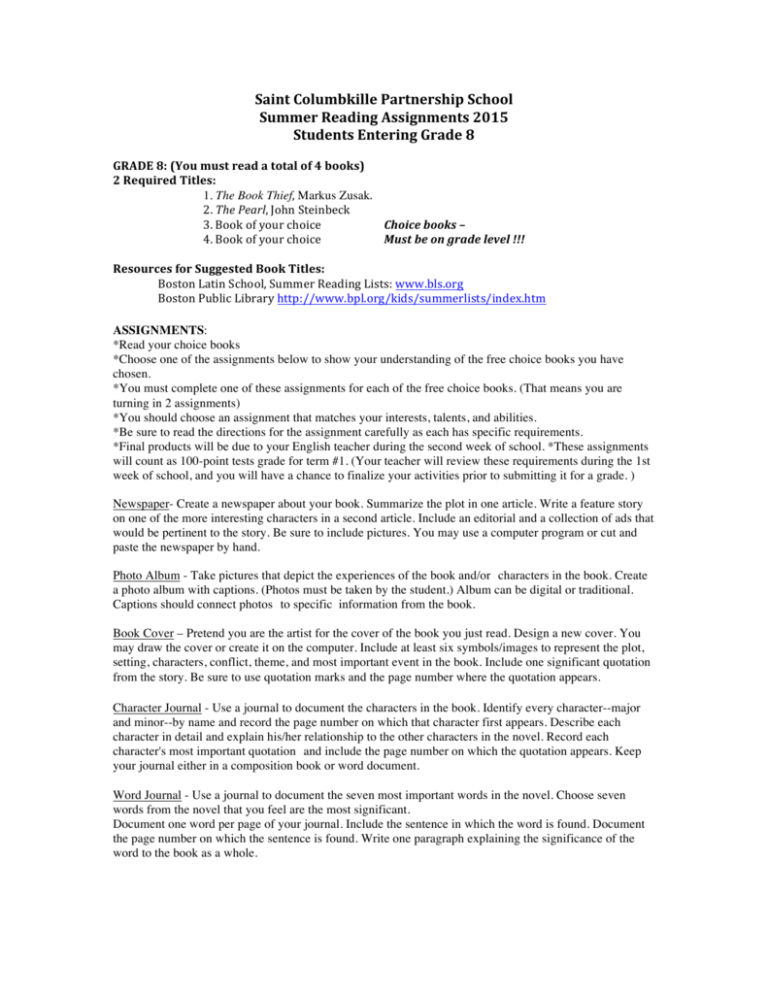
Saint Columbkille Partnership School Summer Reading Assignments 2015 Students Entering Grade 8 GRADE 8: (You must read a total of 4 books) 2 Required Titles: 1. The Book Thief, Markus Zusak. 2. The Pearl, John Steinbeck 3. Book of your choice Choice books – 4. Book of your choice Must be on grade level !!! Resources for Suggested Book Titles: Boston Latin School, Summer Reading Lists: www.bls.org Boston Public Library http://www.bpl.org/kids/summerlists/index.htm ASSIGNMENTS: *Read your choice books *Choose one of the assignments below to show your understanding of the free choice books you have chosen. *You must complete one of these assignments for each of the free choice books. (That means you are turning in 2 assignments) *You should choose an assignment that matches your interests, talents, and abilities. *Be sure to read the directions for the assignment carefully as each has specific requirements. *Final products will be due to your English teacher during the second week of school. *These assignments will count as 100-point tests grade for term #1. (Your teacher will review these requirements during the 1st week of school, and you will have a chance to finalize your activities prior to submitting it for a grade. ) Newspaper- Create a newspaper about your book. Summarize the plot in one article. Write a feature story on one of the more interesting characters in a second article. Include an editorial and a collection of ads that would be pertinent to the story. Be sure to include pictures. You may use a computer program or cut and paste the newspaper by hand. Photo Album - Take pictures that depict the experiences of the book and/or characters in the book. Create a photo album with captions. (Photos must be taken by the student.) Album can be digital or traditional. Captions should connect photos to specific information from the book. Book Cover – Pretend you are the artist for the cover of the book you just read. Design a new cover. You may draw the cover or create it on the computer. Include at least six symbols/images to represent the plot, setting, characters, conflict, theme, and most important event in the book. Include one significant quotation from the story. Be sure to use quotation marks and the page number where the quotation appears. Character Journal - Use a journal to document the characters in the book. Identify every character--major and minor--by name and record the page number on which that character first appears. Describe each character in detail and explain his/her relationship to the other characters in the novel. Record each character's most important quotation and include the page number on which the quotation appears. Keep your journal either in a composition book or word document. Word Journal - Use a journal to document the seven most important words in the novel. Choose seven words from the novel that you feel are the most significant. Document one word per page of your journal. Include the sentence in which the word is found. Document the page number on which the sentence is found. Write one paragraph explaining the significance of the word to the book as a whole. The Pearl by John Steinbeck Study Guide Questions Students will be expected to complete the Study Guide provided. This will be collected during the first week of school. CHAPTER 1 1. Who are the three important characters? 2. Describe each character using at least 2-3 details. § § § 3. What kind of lifestyle do they have? 4. What evidence of belief in superstition can you find? 5. Copy examples from the novel that show the author’s use of description. Cite page #s. § § § 6. With what event in this chapter does the real action of the story begin? 7. Describe how Kino’s life is symbolized in “songs.” What contrasting songs are emphasized at different times? 8. What is the difference between the “city of grass huts” and the “city of stone”? How are we made aware of the difference (quote)? 9. In chapter one, we meet the doctor. Three different characterizations of the doctor are suggested. Distinguish between them: (all three should be different even if only slightly) § The doctor as seen by the beggars § § The doctor as seen by himself § The doctor as seen by Kino CHAPTER 2 10. Use at least three details (quotes) about the town to make inferences about the lifestyle of the villagers. Cite page #s and say what is inferred. § § § 11. What object of great value had Kino’s grandfather brought from Nayarit, and why was it so valuable? 12. How are pearls created by oysters (quote)? 13. Describe, in detail, how Kino searched for pearls. 14. Why do Kino’s people sing songs? Give an example of a song, and tell why it was sung. 15. Why does Kino want to save one particular oyster to open last? 16. After Kino finds the great pearl, what happens to Coyotito? 17. In the selling the pearl, what disadvantages and advantages did Kino have? Include at least one for each) § disadvantages § advantages * Not a mistake. There are no Chapter 3 questions. Just read it J CHAPTER 4 18. Explain the public attitude the dealers had toward Kino and his “Pearl of the World”? Why was it different than their private attitude (what they thought behind Kino’s back)? 19. What did the townspeople think Kino should do with his “Pearl of the World”? Why? 20. By the end of Chapter 4, what decision had Kino reached concerning what to do with the pearl? Was he right or wrong to do what he did? Why? CHAPTER 5 21. With what important incident did this chapter begin? 22. What incident in this chapter put peace behind Kino and Juana forever? 23. What additional event(s) made it impossible for Kino and Juana to remain in the village? 24. How did Kino and Juana spend their last day in the village? 25. By the end of this chapter, the pearl has become a moral issue to Kino. How does he express it (quote)? How do you explain it? CHAPTER 6 26. How does the author describe Kino at the beginning of this chapter? 27. This chapter might be subtitled “the flight.” Trace it through the important incidents that happened. List at least 4 things. § § § § 28. Describe the return of the family to the village. 29. What was Kino’s final action? Why? 30. Now that you have finished reading the book, explain why the foreword says this story might be a parable? The Book Thief, Markus Zusak Summer Reading Study Guide Assignment The questions on this page should be answered separately from this page. You can do it on a Word document, a Google doc, or by hand on lined paper. This is due the first week of school. Understanding point of view: The narrator of a story provides the details of the story from his or her point of view (perspective). Since The Book Thief is told from the perspective of a narrator who is also a character in the story, it is told from the first person point of view. Why might Zusak have chosen to tell the story using first person narration? How does Zusak’s choice of Deathas the narrator affect the story? What aspects of the novel would change if another character narrated the tale? Provide quotes and examples to support your responses. You might consider the following characters as possibilities: Liesel, Liesel’s brother, Frau Diller, Rosa Hubermann, Hans Hubermann, Ruby Steiner, Max Hubermann. Understanding literary devices: Authors use a variety of literary devices, or strategies, in order to get their meaning across to their readers. The type of literary devices an author uses may depend on his or her audience, purpose, or style of writing. In The Book Thief, Markus Zusak uses many examples of figurative language, such as simile, metaphor, personification, and onomatopoeia. The Following passages are examples. Why might Zusak have chosen to use the following literary devices in his writing? What purpose might he have? 1. Simile: Comparison using “like” or “as” “To her right a book protruded like a bone.” (450) 2. Personification: Giving qualities of a person to something inanimate. “The sound of crying children kicked and punched” (380). 3.Onomatopoeia: Original words that name sounds “Grimly she realized that clocks don’t make a sound that resembles ticking, tocking.” (259) 4. Metaphor: Comparison without “like” or “as” “Another human pendulum. Another clock, stopped.” (502) 5. List and discuss at least 5 other examples of figurative language that you find throughout the novel. If you have any questions, please contact me at: jwesner@stcps.org
